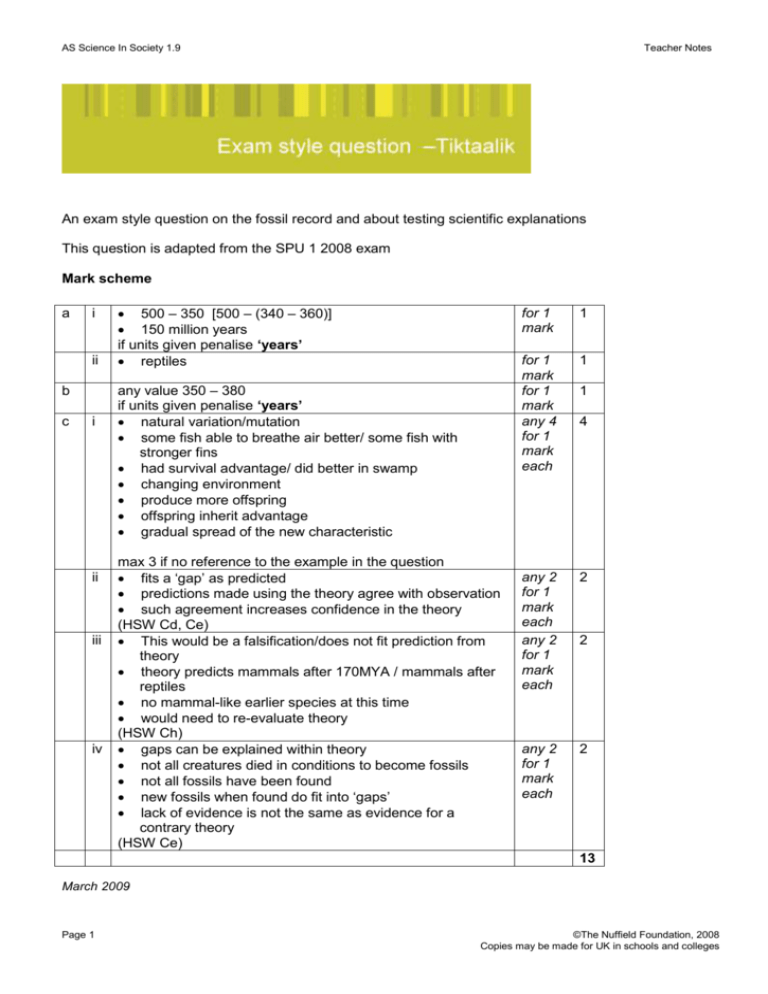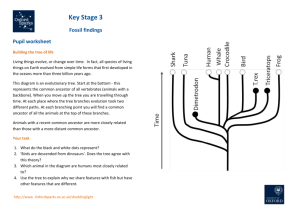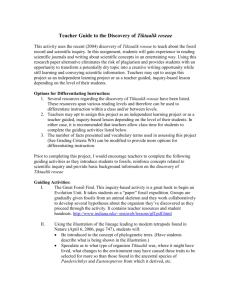Teacher notes and student sheets
advertisement

AS Science In Society 1.9 Teacher Notes An exam style question on the fossil record and about testing scientific explanations This question is adapted from the SPU 1 2008 exam Mark scheme a i ii b c i ii iii iv 500 – 350 [500 – (340 – 360)] 150 million years if units given penalise ‘years’ reptiles any value 350 – 380 if units given penalise ‘years’ natural variation/mutation some fish able to breathe air better/ some fish with stronger fins had survival advantage/ did better in swamp changing environment produce more offspring offspring inherit advantage gradual spread of the new characteristic max 3 if no reference to the example in the question fits a ‘gap’ as predicted predictions made using the theory agree with observation such agreement increases confidence in the theory (HSW Cd, Ce) This would be a falsification/does not fit prediction from theory theory predicts mammals after 170MYA / mammals after reptiles no mammal-like earlier species at this time would need to re-evaluate theory (HSW Ch) gaps can be explained within theory not all creatures died in conditions to become fossils not all fossils have been found new fossils when found do fit into ‘gaps’ lack of evidence is not the same as evidence for a contrary theory (HSW Ce) for 1 mark 1 for 1 mark for 1 mark any 4 for 1 mark each 1 any 2 for 1 mark each any 2 for 1 mark each 2 any 2 for 1 mark each 2 1 4 2 13 March 2009 Page 1 ©The Nuffield Foundation, 2008 Copies may be made for UK in schools and colleges AS Science In Society 1.9 Student sheets When Darwin proposed his theory of evolution by natural selection one of the most important types of evidence he used to support the idea was the fossil record. Fossils form when creatures die in particular circumstances that allow their bodies to be preserved as minerals. Fossils are found in different layers of rock, deeper rock layers are usually older. The age of a fossil can be estimated from the age of the rock layer it is found in. Figure 1 shows the evolutionary relationship between some important classes of animals. The estimated age of the oldest fossils for each class are indicated by the horizontal lines on the diagram. Figure 1 Some evolutionary relationships fish amphibians reptiles mammals dinosaurs birds 140 160 180 200 220 millions of years ago (mya) 240 260 280 300 320 340 360 380 400 420 440 460 480 500 520 wide range of sea creatures 540 (a) (i) From the information in Figure 1 make an estimate of how long it took for the amphibians to evolve from the first fish. ................................................................................................................................................... (1 mark) Page 1 ©The Nuffield Foundation, 2008 Copies may be made for UK in schools and colleges AS Science In Society 1.9 Student sheets (ii) Which class of animals is most closely related to mammals according to Figure 1? ................................................................................................................................................... (1 mark) (b) One important evolutionary change is from fish to amphibians, the first air breathing, four-legged animals. Until 20 years ago almost no fossils had been found that were intermediate between the two. Critics of evolution referred to a ‘missing link’. However scientists predicted that such intermediates would be found. In what age of rock would they have predicted that intermediates, showing features of both fish and amphibians, should be found? ................................................................................................................................................... (1 mark) (c) Several such fossils have now been found, exactly as predicted. Figure 2 shows some of these intermediate forms in order of age, with the oldest at the bottom. Figure 2 Reconstructions of some fossils intermediate between fish and four-legged air-breathing animals A no fossil evidence for Tiktaalik rear B Tiktaalik C (i) Use Darwin’s theory of evolution to explain the process by which the four-legged land animal, A, may have evolved, over about 20 million years, from the fish-like creature, C, in the swampy conditions of the time. ................................................................................................................................................... ................................................................................................................................................... ................................................................................................................................................... ................................................................................................................................................... (4 marks) Page 2 ©The Nuffield Foundation, 2008 Copies may be made for UK in schools and colleges AS Science In Society 1.9 Student sheets (ii) Tiktaalik was only found in 2004 and aroused great interest. Explain why scientists thought this was a very significant finding. ................................................................................................................................................... ................................................................................................................................................... ................................................................................................................................................... ................................................................................................................................................... (2 marks) (iii) If a mammal fossil were ever to be found in rocks that date from 400mya, this would be strong evidence that our current understanding of evolutionary relationships is incorrect. Explain why. ................................................................................................................................................... ................................................................................................................................................... ................................................................................................................................................... ................................................................................................................................................... (2 marks) (iv) Those who oppose the theory of evolution often claim that gaps in the fossil record are important evidence against the theory. Explain why this is not a valid conclusion. ................................................................................................................................................... ................................................................................................................................................... ................................................................................................................................................... ................................................................................................................................................... (2 marks) Total 13 marks Page 3 ©The Nuffield Foundation, 2008 Copies may be made for UK in schools and colleges






